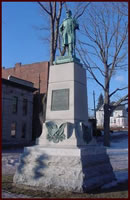
Early in July 1862, after McClellan's failure to capture Richmond, a call from Washington resulted in Colonel Ellis being commissioned to enlist men in Orange and Sullivan counties to form the 124th Regiment, N.Y. Volunteer Infantry. Recruiting progressed in several places and Company A was completed under CApt. Hezekiah Watkins, 1st Lt. Wm. A. Ratcliff, and Lt. George Young and met at Monticello to proceed to Goshen as part of the 124th Regiment. In the meantime, Judge Henry R. Low, John C. Holley, and others were active in securing authority to enlist a regiment in Sullivan County alone, and arrived at Monticello with such authority in time to stop the departure of Company A. A War Committee including Judge Low, Hon. C.V.R. Ludngton, John C. Holley and others was appointed to push the enlistment and formation of companies as rapidly as possible. Company A was already completed, with headquarters at Monticello. Companies, E, F, H, and K were enlisted and included some Monticello recruits. Companies B, C, D, and I were recruited in other villages in the County, with Companies D and I secured largely from Tompkins County, by whose active influence the Hon. C.V.R. Ludington, in order to promptly complete the 143rd Regiment and secure the desired regimental number and rank.
Camp HolleyThe nine companies named were brought together in camp on the northeastern shore of Pleasant Lake, since renamed Kiamesha, about two miles from Monticello.
The camp was named "Camp Holley" in honor of John C. Holley, who had been appointed Colonel of the Regiment on August 14, 1862, but was never commissioned as such. The War Committee deemed it wise to secure a man to command the regiment who had a military education, and had served at the front. Such a one was found in Col. David P. DeWitt. John C. Holley was appointed Lt. Colonel, but declined, and Horace Boughton came to the 143rd Regiment in October 1862 -- then was mustered in as Lt. Colonel.
Barracks with board bunks were erected for the accommodation of the regiment, and a cook-house, large enough to accommodate one company at at a time, was built down by the water. The contract for supplying and preparing provisions was given to O'Neil & Royce, but the boys soon became dissatisfied with their rations. Very little butter -- and that rancid -- was the cause of a rebellion among the men which ended with but a remnant of the cook-house remaining, and two men (O'Neil and Royce) racing across the pasture field as if their lives, evidently thinking it too late in the season to enjoy a bath in the lake for the amusement of the boys.
The preparatory stage of the soldier's life, such as running the guard, smashing cook-houses, sealing stone walls, and grumbling generally came to an end, and the dawn of October 10th, 1862 found the camp in an uproar with orders to report with the Regiment at New York City. Every man had a "pepper-box", or six-shooter, of some sort tucked away somewhere in his outfit -- no matter what his clothing situation was!
The bugle sounded the call, the long line (1,007 stalwart young men) formed, the new flag was flung to the breeze, and with easy swing, they soon reached the turnpike and halted on the flat just east of Monticello. Friends and relatives had gathered to say the parting word to brothers, sweethearts, sons, husbands, and fathers. Little did they realize that the end of the war would find 187 of these loved ones unable to return.
The 143rd was an active participant in the great Atlantic campaign of May 5, 1864, and had its full share of honors and casualties. The Regiment was with General Sherman in his great movements from Atlanta to the sea -- "On to Richmond" -- Lee's surrender to Grant -- Johnston's surrender to Sherman -- March through Richmond to Washington -- and the Grand Review before the President and Generals' Sherman and Grant.
"Who were these men being reviewed for the last time? They were the men who had escaped death by shot and shell! They were the men who had not succomed to sickness, they were the men who had defied fatigue and hardships. They were the survivors of war's siftings!"
The 143rd Regiment was mustered out of service on July 20, 1865.
Ffrom Historical Journal: Monticello Sesquicentennial, 1804-1954, Monticello Sesquicentennial Committee.
|
According to former Monticello village manager George Panchyshyn, writing in an e-mail on February 21, 2001: "Camp Holley was located along what is now route 42 (then the Newburgh / Cochecton Turnpike) about 500 feet before the traffic light in Kiamesha Lake. Around the same area as United Beverage's garage. It was located on the shoreline and extended in both directions from there. The encampment held troops and recruits awaiting departure. About 17 years ago a civil war oven was found in the mud during a drought and the lake level was very low. There was a cast marker posted along route 42 at the spot the camp was located but was taken down for refurbishing." |

RELATED EXTERNAL LINKS
143rd New York Volunteer Infantry, "Sullivan County Regiment" history and campaigns
A Small Community Goes To War views from Middletown, New York by Frank S. Coleman
Civil War era veterans buried in Hillside Cemetery, Middletown including John C. Holley